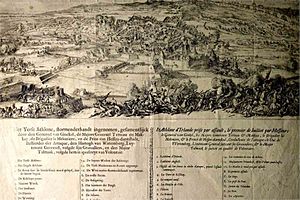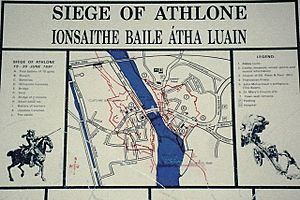Siege of Athlone (1691) facts for kids
Quick facts for kids Siege of Athlone |
|||||||
|---|---|---|---|---|---|---|---|
| Part of Williamite War in Ireland | |||||||
 |
|||||||
|
|||||||
| Belligerents | |||||||
| Commanders and leaders | |||||||
| Strength | |||||||
| 18,000 | 1,500 (garrison only) | ||||||
| Casualties and losses | |||||||
| 60 killed 120 wounded |
1,000 killed | ||||||
The town of Athlone was attacked twice during the Williamite War in Ireland (1689–91). This war was fought between supporters of King William III (called Williamites) and supporters of King James II (called Jacobites). Athlone is in the middle of Ireland on the River Shannon. It controlled the main bridge over the river, which was very important for moving into Jacobite-held lands. Because of this, Athlone was a key place to control.
Contents
Why Athlone Was Important
The first time William III's army tried to take Athlone was in 1690. This happened after they won a big battle called the Battle of the Boyne. About 7,500 Williamite troops, led by James Douglas, tried to capture the town. But the Jacobite commander, Colonel Richard Grace, refused to give up. Since Douglas did not have large cannons to break down the walls, he had to leave after a week.
In the summer of 1691, the Williamite army came back. They were led by a Dutch general named Godart de Ginkel. They marched to Athlone to try and take it again.
Jacobite Preparations
The main Jacobite army, led by the Marquis de St Ruth, moved to defend Athlone. They set up their forces west of the town. Other Jacobite soldiers guarded the eastern part of Athlone, which was mostly in ruins. They also had troops in the "Irish Town" on the western side of the river. This plan was meant to make the fight last longer. However, the Williamites had higher ground on their side of the river. Also, the river was unusually low, which made it easier to cross.
There were also some disagreements among the Jacobite leaders. This made their defense harder.
The Siege Begins
General Ginkel started his attack on the eastern part of Athlone on June 20. The Jacobites had to pull back to the west side of the river. As they left, they broke down parts of the bridge. Colonel Grace, who had bravely defended Athlone before, was killed by a cannonball on the same day.

The Jacobite forces on the western side of Athlone were led by Major-General Thomas Maxwell. They fought hard against the Williamite attack. There was fierce fighting around the bridge over the River Shannon. The Williamites tried to put wooden planks over the broken bridge. But Irish Jacobite soldiers bravely destroyed these planks, even under heavy fire. One group of volunteers, led by Sergeant Custume, became famous for their bravery, though they all died. The Williamites tried many times to storm the bridge but lost many soldiers.
Heavy Bombardment
The Williamites fired many cannonballs and bombs into the western side of the town. Over 12,000 cannonballs and 600 bombs were shot into Athlone. One soldier wrote that "with the balls and bombs flying so thick, that spot was hell on earth." For ten days, 32 large cannons fired one shot every minute. Athlone suffered the heaviest bombing of any city in Britain or Ireland up to that time.
While planning to storm the bridge, Ginkel found another place to cross the river. It was a shallow spot, called a ford, to the south. To test it, he sent three soldiers to cross the river. They made it across and back safely. Then, Ginkel sent 2,000 special soldiers called grenadiers to cross there. Their plan was to attack the Jacobite positions from behind.
Surprise Attack
There had been another argument between St Ruth and the Jacobite commander in Athlone, d'Usson. Because of this, the defenses on the western side of the city had not been properly prepared. St Ruth finally ordered them to be destroyed on June 29, but it was too late.
The next day, Ginkel's grenadiers quickly took over these defenses. They raised the drawbridge there, stopping counter-attacks from St Ruth's army. This allowed the main Williamite army to move up. St Ruth sent two groups of soldiers to fight the Williamites, but after about an hour and a half of intense fighting, the Jacobites had to retreat.
What Happened Next
The Williamites' breakthrough forced the remaining Jacobite soldiers in Athlone to quickly leave their positions. Maxwell was captured. Some people later accused him of being a traitor. St Ruth and his army pulled back into County Galway.
The Jacobites lost about 1,000 men at Athlone. Some estimates say over 2,000 were lost, including several important commanders.
Ginkel continued marching towards Limerick. He did not know where St Ruth's army was. On July 12, the Williamites found the main Jacobite army in a strong defensive spot at Aughrim. In the battle that followed, Ginkel won a huge victory. This battle effectively ended the Jacobite resistance in Ireland.


